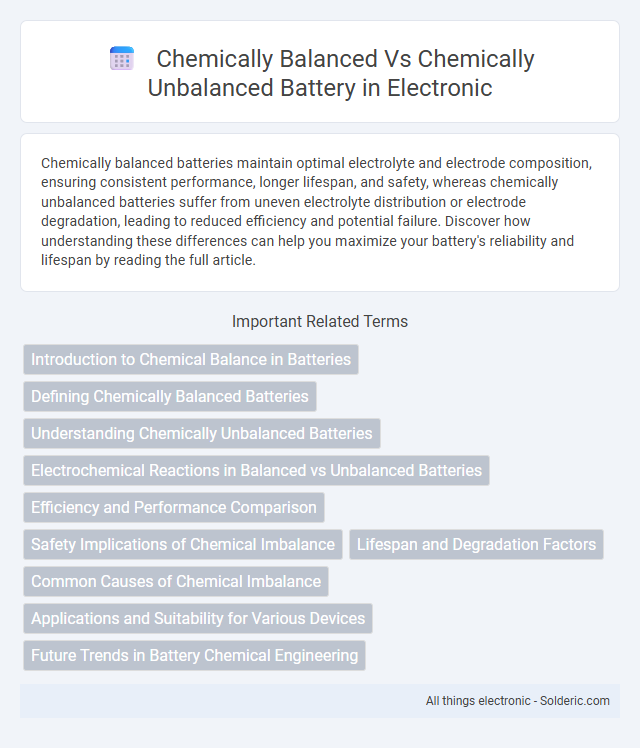Chemically balanced batteries maintain optimal electrolyte and electrode composition, ensuring consistent performance, longer lifespan, and safety, whereas chemically unbalanced batteries suffer from uneven electrolyte distribution or electrode degradation, leading to reduced efficiency and potential failure. Discover how understanding these differences can help you maximize your battery's reliability and lifespan by reading the full article.
Comparison Table
| Feature | Chemically Balanced Battery | Chemically Unbalanced Battery |
|---|---|---|
| Definition | Battery with equal and stable chemical composition across all cells | Battery with uneven or unstable chemical composition between cells |
| Performance | Consistent voltage and capacity output | Inconsistent voltage and reduced capacity |
| Cycle Life | Longer lifespan due to uniform chemical reactions | Shorter lifespan caused by uneven chemical wear |
| Safety | Lower risk of overheating and thermal runaway | Higher risk of overheating, leaks, or failure |
| Efficiency | Higher energy efficiency and charge retention | Lower efficiency with faster self-discharge |
| Cost | Typically higher due to precise manufacturing | Generally lower but with performance trade-offs |
| Applications | High-performance devices, electric vehicles, critical systems | Low-cost applications, backup power, non-critical use |
Introduction to Chemical Balance in Batteries
Chemical balance in batteries refers to the precise equilibrium between the positive and negative electrodes' chemical reactions, ensuring optimal energy storage and discharge efficiency. Chemically balanced batteries maintain stable voltage output and longer cycle life by preventing excessive degradation of active materials. In contrast, chemically unbalanced batteries experience uneven chemical reactions, leading to reduced capacity, increased internal resistance, and premature failure.
Defining Chemically Balanced Batteries
Chemically balanced batteries contain equal proportions of active materials, ensuring efficient ion flow and consistent energy output during use. This balance minimizes internal resistance and prolongs battery life by preventing premature degradation of electrodes. When charging your device, a chemically balanced battery maintains stable voltage and temperature, optimizing overall performance and safety.
Understanding Chemically Unbalanced Batteries
Chemically unbalanced batteries experience uneven distribution of ions and active materials, leading to reduced capacity and accelerated degradation. Understanding these imbalances helps identify issues like sulfation in lead-acid batteries or lithium plating in lithium-ion types, which impair performance and lifespan. Proper maintenance and monitoring can restore balance and extend your battery's operational efficiency.
Electrochemical Reactions in Balanced vs Unbalanced Batteries
Electrochemical reactions in chemically balanced batteries proceed efficiently, maintaining stable voltage and prolonging battery life by ensuring equal ion flow between electrodes during charge and discharge cycles. In chemically unbalanced batteries, inconsistent ion distribution leads to uneven electrode reactions, causing reduced capacity, faster degradation, and potential buildup of harmful byproducts. Balanced electrochemistry enhances overall battery performance by optimizing reaction kinetics and minimizing internal resistance.
Efficiency and Performance Comparison
Chemically balanced batteries maintain optimal electrolyte concentration and electrode composition, ensuring maximum energy efficiency and consistent performance over extended cycles. Chemically unbalanced batteries suffer from uneven reactions, leading to reduced capacity, faster degradation, and decreased overall efficiency. The stability of chemical balance directly impacts the battery's charge retention and power output, making balanced batteries superior in reliability and longevity.
Safety Implications of Chemical Imbalance
Chemical imbalance in batteries leads to unstable electrochemical reactions that increase the risk of overheating, leakage, and even explosion, compromising overall safety. Chemically balanced batteries maintain optimal ion flow and stable temperature, significantly reducing hazards during operation and charging. Your safety depends on using batteries designed with consistent chemical formulations to prevent dangerous failures and extend device longevity.
Lifespan and Degradation Factors
Chemically balanced batteries maintain optimal ion distribution, which significantly extends lifespan by reducing internal stress and minimizing degradation factors such as dendrite formation and electrolyte breakdown. Chemically unbalanced batteries experience uneven chemical reactions, accelerating capacity loss and increasing the risk of malfunction over time. To maximize your battery's lifespan, ensure it operates within recommended voltage and temperature ranges to prevent chemical imbalances.
Common Causes of Chemical Imbalance
Common causes of chemical imbalance in batteries include overcharging, which leads to excessive heat and accelerates electrolyte degradation, and deep discharge cycles that precipitate irreversible chemical changes in the electrodes. Impurities in the electrolyte and manufacturing defects can also disrupt the chemical equilibrium, causing reduced battery efficiency and shortened lifespan. Proper maintenance and optimal charging routines help keep your battery chemically balanced, ensuring reliable performance.
Applications and Suitability for Various Devices
Chemically balanced batteries, such as lithium-ion cells, offer stable voltage output and longer cycle life, making them ideal for high-performance devices like smartphones, laptops, and electric vehicles. Chemically unbalanced batteries, often found in lower-cost or older technologies like nickel-cadmium, exhibit rapid capacity loss and voltage fluctuations, limiting their use to less demanding applications such as remote controls or emergency backup systems. Selecting the appropriate battery type depends on the device's power requirements, longevity needs, and operational stability under varying conditions.
Future Trends in Battery Chemical Engineering
Future trends in battery chemical engineering emphasize the development of chemically balanced batteries with optimized electrolyte composition and electrode materials to enhance energy density, cycle life, and safety. Research targets mitigating issues in chemically unbalanced batteries, such as dendrite formation and capacity fade, through advanced coatings and solid-state electrolytes. Innovations in nanotechnology and machine learning drive precise control over chemical reactions, pushing the boundaries of battery performance and sustainability.
Chemically balanced vs Chemically unbalanced battery Infographic

 solderic.com
solderic.com